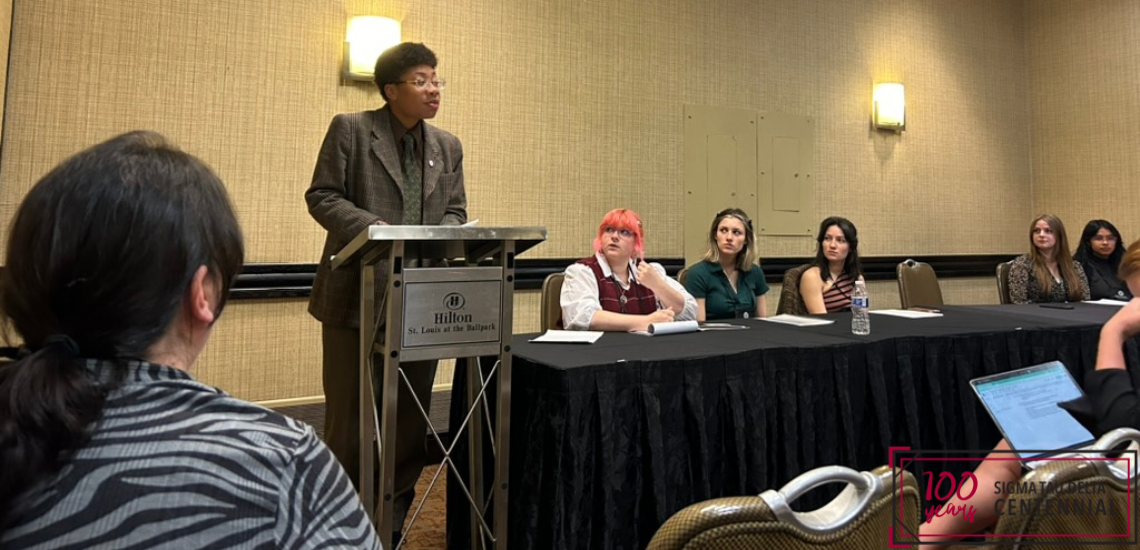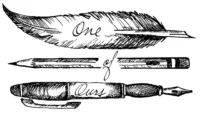
Picked to Present at the Convention? What Do I Do Now?
Presenting your first paper may feel like an exciting or perhaps daunting task. It is the act of sharing your meticulously written and edited paper to a room of people, something akin to baring a part of your soul to the public. While some of us may feel confident in our ability to present, others may not be entirely confident yet and both are okay!
I had the privilege to present my first paper at the Sigma Tau Delta 2024 Centennial Convention in St. Louis, MO, and I remember feeling a flurry of celebration, anticipation, and nervousness at the thought of reading my paper out loud. Aside from a few college presentations, I barely had any experience presenting at a professional and national level. I didn’t know what to expect and how to prepare for it since I could not even begin to imagine what presenting at the convention would look like. Fortunately, my Chapter Advisor and fellow chapter members, who were also presenting at the convention, lent me their time, encouragement, and advice in my journey to preparedness.
The first thing that significantly calmed my nerves was getting a rundown of the event. When your paper is accepted to present, you will receive a schedule that includes the room and time slot of your presentation. On the presentation day itself, how you spend the time leading up to your presentation is entirely up to you. Aside from possible mandatory events, you can choose to take some time to yourself, practice, or distract yourself before your time slot. However, it is recommended to be in your designated presentation room five minutes before it starts to allow yourself some time to settle in. While rooms vary from convention to convention, they usually consist of chairs set up theatre style with a walkway down the middle, a long table at the front, and a podium. I did not have a podium in my room, but the general layout stays the same for every room. There will be a session chair who will introduce the presenters and a moderator who will facilitate the Q&A discussion after the presentations. That’s all you basically need to know to get a good idea of what presenting will look like at the convention.
Now for the strategies that I learned as I was preparing. An obvious one would be to practice, practice, practice. The best way to ensure that you are prepared is to rehearse, whether it is in front of a mirror, a friend, or a group of people. Practicing allows you to familiarize yourself with reading your paper out loud, which includes where to stop, how fast to read, when to flip the pages, and so many more details that you will only discover when you try it yourself. My chapter hosted a mock presentation where we invited guests and staged the room to mimic the presentation atmosphere. It was there that I discovered my reading style and nervous tics. Thus, I would genuinely recommend practicing with yourself and others to familiarize yourself with the feel of presenting. Another tip I learned was to look into a mirror as you rehearse and be aware of how often you make eye contact with yourself. Your presentation shouldn’t be just you glued to a paper that you are reading out loud. Eye contact with the audience encourages engagement with you and your work.
There are many other strategies and pieces of advice that can be given to first-time presenters, but the best way to find out what works for you is to practice, get feedback, and revise. Seek out others who have or are presenting because experienced advice and group motivation are great assets. As I was so fortunate to receive help during my preparations, I hope that this may provide some comfort and guidance to some of you too. You’re not alone. We’re all rooting for each other to be great! Presenting your meticulously written paper to a room of supporters and like-minded individuals is a gratifying experience, so being able to fully enjoy the journey and the event is important! All the best on your presenting endeavors, and I can’t wait to hear them at the 2025 Convention!
 Carmen Lok
Carmen Lok
Student Representative, Southwestern Region, 2024-2025
Epsilon Theta Chapter, Secretary
Southern Arkansas University, Magnolia, AR
Tips for Presenting at the Convention
The following guidelines can greatly improve your performance and enhance your presentation of your creative work, paper, or roundtable.
- Practice reading your accepted work in advance of your presentation. Make sure that you can read the work in under 15 minutes; consider making pronunciation notes for difficult names or words.
- Check out the location and time in advance. Know where and when your session is to be held to minimize feeling rushed.
- Arrive for your session at least five minutes prior to the start time, introduce yourself to the session chair and moderator, and confirm the pronunciation of your name.
- Stand at the podium to read your paper or creative work. If the room has no podium, consider standing anyway–your voice projects more when you stand than when you sit, and the audience will be able to see you.
- Observe time limits and keep under 15-minute time limit, not only as a courtesy to your fellow presenters, but also to allow time for questions at the end of the session. Watch your moderator for a subtle sign that you have reached your time limit.
- Enunciate, and speak audibly and slowly enough so listeners can follow along. With the exception of minor revisions to improve grammar or readability, do not improvise or deviate from the work that was accepted for convention.
- Practice good speech-giving strategies. Be aware of your body language and of the eye contact you keep with your audience. Since the attention of your listeners should be on your words, avoid anything that draws their attention away from your words. Consider bringing a handout so that your audience has something to guide them to important points in your paper as they listen and so that they have something to write on during your presentation. You might also consider a QR code for digital handout access.
- Listen to fellow panelists and jot down thoughtful comments or questions to ask them.
- Save your improvisational skill for the question period, when you will need it. Then answer questions from the audience clearly and concisely.
- Remember—you are among friends. At a conference, where you are sharing your ideas with strangers, you may feel vulnerable to their criticism. But remember that your peers feel the same way—and that you can return the favor of their careful attention in their sessions.
- Dress professionally. Presenters generally choose to present in business or “business casual” attire. While your comfort is important, your clothing should signify that you are to be taken seriously. Make sure that your shoes are comfortable to stand in for fifteen minutes.
